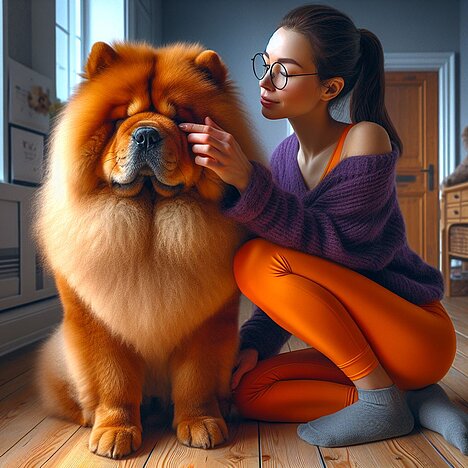Discharge from the eyes

Discharge from the eyes in dogs is a common symptom that can have various causes. In this article, you'll find out what the possible causes of eye discharge are, how to clean it properly and when you should go to the vet.
What is eye discharge in dogs?
The medical term for eye discharge in dogs is epiphora. This means that your dog's eyes are excessively watery and moist. The discharge can be a clear, watery fluid, which is usually harmless, or a mucous or purulent substance that indicates an infection or inflammation.
The discharge can accumulate in the fur around the eyes and crust over. This can lead to skin irritation, odor and infection. The discharge can also affect your dog's vision and cause discomfort.
What are the causes of eye discharge in dogs?
There are many possible causes of eye discharge in dogs. Some of them are:
- Allergies: If your dog is allergic to something, such as pollen, dust or food, his eyes may become watery and itchy. This can lead to conjunctivitis, which manifests itself as red, swollen and pus-filled eyes.
- Foreign bodies: If something gets into your dog's eye, for example a blade of grass, a grain of sand or an insect, this can lead to irritation, injury and infection. Your dog will try to get rid of the foreign body by blinking, scratching or rubbing.
- Injuries: If your dog has injured his eye, for example through a scratch, bite or bump, this can lead to bleeding, swelling and inflammation. The eye may also become cloudy or discolored.
- Hereditary deformities: Some dog breeds have a genetic predisposition to certain eye conditions that can lead to eye discharge. These include, for example, brachycephalic breeds such as pugs or bulldogs, which have protruding eyes and are prone to dry eyes or problems with the tear duct. Or breeds with drooping eyelids such as St. Bernards or bloodhounds, which tend to have a deformity called ectropion, where the lower eyelid rolls outwards, leaving the eye unprotected.
- Infections: If your dog is suffering from a bacterial or viral infection, such as distemper or herpes virus, their eyes can become pus-filled and sticky. This can lead to serious complications such as corneal ulcers or blindness.
- Tumors: If your dog has a tumor in his eye, for example a melanoma or squamous cell carcinoma, this can lead to a change in the shape or color of the eye. The tumor can also put pressure on the eye and cause pain and tearing.
- Glaucoma: If your dog suffers from glaucoma, it has increased intraocular pressure, which causes damage to the optic nerve. Glaucoma can be acute or chronic and can manifest itself with symptoms such as red, hard and watery eyes.
How do you clean your dog's eye discharge?
If you know the reason for your dog's eye discharge and he doesn't have a serious condition, you can clean it at home. You will need:
- A clean, soft cloth or gauze bandage
- Lukewarm water or a special eye cleaning solution for dogs
- A pair of scissors
This is how you proceed:
- Carefully trim the fur around your dog's eyes with scissors to avoid matting and incrustations.
- Moisten the cloth or gauze pad with water or the eye cleaning solution. Never use soap, alcohol or other irritating substances.
- Hold your dog gently and wipe away the discharge from the inside out. Use a new wipe or gauze pad for each eye to avoid cross-contamination.
- Repeat the process until the discharge is completely removed.
- Gently dry your dog's eyes with a clean cloth.
- Praise your dog and reward him with a treat.
When should you go to the vet?
If your dog's eye discharge persists, worsens or is accompanied by other symptoms, you should see a vet as soon as possible. This is especially true if you notice the following:
- The discharge is yellow, green or bloody
- The eye is red, swollen or cloudy
- The eye is painful or sensitive to light
- The eye has an unusual shape or color
- Your dog has problems seeing or bumps into things
- Your dog has a fever, loss of appetite or lethargy
The vet will examine your dog's eye and, if necessary, carry out tests to make a diagnosis. They will then recommend the appropriate treatment, which may vary depending on the cause. This could be an ointment, gel, spray or drops for the eye, for example, or antibiotics, painkillers or surgery.
How can you prevent eye discharge in your dog?
There are a number of preventative measures you can take to avoid or reduce eye discharge in your dog. These include:
- Keep the fur around your dog's eyes short and clean
- Clean your dog's eyes regularly with a damp cloth or eye cleaning solution
- Protect your dog's eyes from dust, wind, sun and foreign objects with goggles or a visor
- Avoid allergens that can irritate your dog's eyes, such as pollen, dust or perfume
- Have your dog examined regularly by a vet to detect and treat possible eye diseases at an early stage
Eye discharge in dogs is a common symptom that can have various causes. In most cases it is harmless and can be easily cleaned. In some cases, however, it can also indicate a serious condition that requires veterinary treatment. Therefore, you should always pay close attention to your dog's eye health and consult a vet if necessary.
The authors assume that a veterinarian should be consulted if an animal is ill and that medication should only be taken after consultation with a doctor or pharmacist. Only an individual examination can lead to a diagnosis and treatment decision.
We help you find the nearest vet → This way